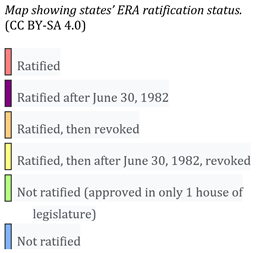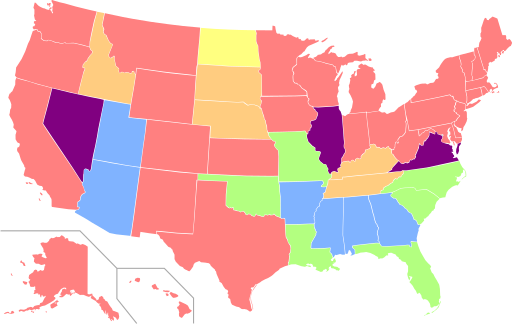What Is the ERA?

Looking back at history, as reported by our LWVUS president, Deborah Turner, it was Abigail Adams’s advice to her husband John to “remember the ladies.” He didn’t. He and the rest of the founders left any mention of women out of the U.S. Constitution.
Suffrage leader Alice Paul first drafted the Equal Rights Amendment (ERA) in 1921 to correct that omission. She recognized that the Nineteenth Amendment alone would not provide equal treatment for women—and history has proven her right. The Nineteenth Amendment did not go far enough to guarantee voting rights for all women, leaving many women of color and those with limited financial status as targets of oppression, suppression, and discrimination.
The text of the ERA states:
Section 1. Equality of rights under the law shall not be denied or abridged by the United States or by any State on account of sex.
Section 2. The Congress shall have the power to enforce, by appropriate legislation, the provisions of this article.
Section 3. This amendment shall take effect two years after the date of ratification.
The ERA would put protection for women and other marginalized genders into the U.S. Constitution and pave the way for gender equity.
History of Deliberations
The ERA was first introduced into Congress in 1923 but failed to pass. Finally, in 1971, it was re-introduced into Congress by Representative Martha Griffiths.
Unlike today, in the 1970s both parties supported the ERA, with a bipartisan House approval of 354–24 in 1971 and, the next year, Senate approval by a bipartisan vote of 84–8. Article 5 of the Constitution sets out two requirements for amendments: approval by two-thirds of both chambers of Congress and ratification by three-fourths (thirty-eight) of the states.
Since passage of the Eighteenth Amendment, which repealed prohibition, Congress has sometimes included a seven-year deadline for ratification by the states. The ERA was not ratified within the stipulated seven-year window. When the original deadline was not met, Congress extended the deadline to 1982. The 1982 deadline lapsed when the ERA fell three states short of the thirty-eight needed for ratification.
In 2017, Nevada became the first state in forty-five years to pass the ERA, followed by Illinois in 2018 and Virginia in 2020. On October 23, 2021, Representative Carolyn Maloney, chair of the House Committee on Oversight and Reform, held a hearing, attended by ERA advocates and a constitutional law scholar, where it was affirmed that the amendment is fully and validly ratified and is now part of the Constitution, irrespective of the seven-year constraint.


What’s Happening Now?
The Constitution is clear on the matter of when an amendment takes effect: “Amendments . . . shall be valid to all Intents and Purposes, as Part of this Constitution, when ratified by the Legislatures of three fourths of the several States, or by Conventions in three fourths thereof. . . .” Although a handful of ratifying states have declared that they have rescinded or revoked ratification, such actions are not recognized in the Constitution and have in the past been rejected when a few states attempted to do the same after ratifying the Fourteenth, Fifteenth, and Nineteenth Amendments.
So what’s holding things up? Well, the final ministerial step to make a constitutional amendment official is for the U.S. archivist to verify the ratifications and then draft a formal proclamation certifying that the amendment is valid and is part of the Constitution. The archivist’s certification is then published in the Federal Register and U.S. Statutes at Large, which serves as official notice to Congress and the nation that the amendment process has been completed.
But these final steps were never taken. Even before Virginia ratified the ERA, the Trump-era Department of Justice’s Office of Legal Counsel (OLC) issued a thirty-eight-page opinion arguing that the three recent ratifications were invalid because they came too late. The archivist declined to certify the ERA, citing deference to the OLC’s opinion. A recent article in The Atlantic reports that the current archivist, David Ferriero, will be retiring and the appointment of a new archivist will be in the hands of President Biden. The ERA Coalition members recently met with Ferriero. He told them that publishing the amendment would be a crowning moment of his career. Knowing that President Biden will not involve the DOJ, those who support the ERA are hoping that the Twenty-eighth Amendment will be certified and registered before the retirement of Archivist Ferriero.
Why Is the ERA Important?
In answer to the question, So why do we need the ERA? LWVUS President Turner has stated:
We need the ERA because we need equal pay, fair healthcare coverage that addresses maternal mortality and coverage for caregivers, protection against gender testing laws, prevention of discrimination against LGBTQ+ persons, protections for men in occupations and roles traditionally held by women, and protection against rollbacks in women’s rights.
We need the ERA because, just as many women of color faced added barriers for voting until the Voting Rights Act, today women of color are more likely to be under-paid and discriminated against than white women. The ERA would make the Constitution prohibit discrimination on the basis of race AND sex.
But more than that, we need the ERA because our nation must close the book once and for all on the idea that equality of rights is a debatable issue. . . .
March is Women’s History Month. Let’s make history by establishing gender equality in our Constitution, once and for all. TAKE ACTION: Tell Congress to remove the ERA ratification deadline!
—Dorothy L. Keane
Further reading:
Baker, Carrie N. “The Equal Rights Amendment Is Ratified—Now What?” Ms., February 10, 2022. Available at https://msmagazine.com/2022/02/10/equal-rights-amendment-ratified/.
Berman, Russell. “The Biden Appointee Who Could Change the Constitution.” The Atlantic, February 9, 2022. Available at https://www.theatlantic.com/politics/archive/2022/02/equal-rights-amendment-constitution/621629/.
Francis, Roberta W. “Frequently Asked Questions.” Available from Equalrightsamendment.org (Alice Paul Institute) at https://www.equalrightsamendment.org/faq.
League of Women Voters. “Equal Rights under the Law: What’s Wrong with That?” Available at https://www.lwv.org/blog/equal-rights-under-law-whats-wrong.
League of Women Voters. “Make Women’s History: Add the ERA to the Constitution.” Available at https://www.lwv.org/blog/make-womens-history-add-era-constitution?utm_source=WomensHistory&utm_medium=email&utm_campaign=03012021&_gl=1*mxqwgy*_ga*MTY1MjkzODc0OS4xNjE4NDIyODY5*_ga_DDCEP0D6KM*MTY0NTE0NzQ5OS41OS4wLjE2NDUxNDc0OTkuMA..&_ga=2.98247455.1845052525.1645147499-1652938749.1618422869.
League of Women Voters. “Take Action: ERA Fight Comes to the 117th Congress.” Available at http://participate.lwv.org/c/10065/p/dia/action4/common/public/?action_KEY=13855&_gl=1*niod3b*_ga*MTY0NDMwOTcwMC4xNjA2NzczOTcz*_ga_DDCEP0D6KM*MTYxNDMwOTA5Ny4xNzguMS4xNjE0MzA5MTY3LjA.
Raby, John. “WVa Senate Rescinds 1972 Equal Rights Amendment Ratification.” Tuscon.com, February 11, 2022. Available at https://tucson.com/news/national/govt-and-politics/wva-senate-rescinds-1972-equal-rights-amendment-ratification/article_809edd4d-4e57-5aa3-bee5-aa49cb3dccca.html.
Stracqualursi, Veronica. “Equal Rights Amendment: Three Senate Republicans Urge Archivist Not to Certify the ERA.” msn.com, February 10, 2022. Available at https://www.msn.com/en-us/news/politics/equal-rights-amendment-three-senate-republicans-urge-archivist-not-to-certify-the-era/ar-AATFNIO.